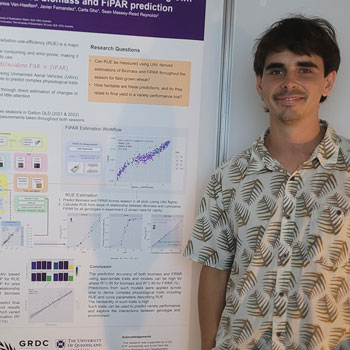Continually evolving production challenges in the grains industry are attracting more students from diverse backgrounds to apply data, analytics and AI to solve them.
The Australian grains industry needs highly capable people to provide insights and decision support to every facet of grain production. To ensure this, GRDC invests significantly in Capacity & Ability, an enabling program that is part of a suite of enablers in the Research, Development & Extension Plan 2023–28.
The objective is to access the best people and technologies from across the globe, including from other industries such as space, mining and medicine. Further to this, GRDC also aims to foster an environment that supports diversity and innovation, connecting people and providing time and space to be creative.
A key vehicle for GRDC’s Capacity & Ability activities are GRDC Research Scholarships. These support PhD candidates to deliver research that addresses or builds opportunities for Australian growers. The three-year top-up scholarships, worth $35,000 a year, provide high-achieving students with financial and industry support to complete their PhD in an area aligned with GRDC’s RD&E Plan.
The following snapshots showcase the work of three GRDC Research Scholars whose studies align with big data and phenomics investments.
Daniel Smith, University of Queensland
Principal supervisor: Scott Chapman
Thesis: Improving variety prediction using environment information
 Daniel Smith presenting his poster at the Australian Society of Plant Sciences meeting in Hobart, 2023. Photo: Shanice Van Haefton
Daniel Smith presenting his poster at the Australian Society of Plant Sciences meeting in Hobart, 2023. Photo: Shanice Van Haefton
After switching from an undergraduate photography degree to agricultural science at the University of Queensland in 2014, Daniel Smith undertook several undergraduate research scholarships where he found that photography could be used to solve complex scientific problems.
Completing his undergraduate studies in 2018, Daniel began a PhD study in 2020 at the University of Queensland under Professor Scott Chapman at the School of Agriculture and Food Sustainability.
Daniel is exploring UAV-based high-throughput phenotyping (HTP) approaches for the prediction of wheat biomass across multiple environment types and at multiple growth stages across crop development.
Unmanned aerial vehicles (UAVs) are increasingly used by plant breeders to improve speed and accuracy of measuring plant traits in field plots and are significantly reducing the cost of field data collection. The use of UAVs has been validated for measuring time of flowering and crop canopy height.
With other sets of measurements, it is possible to estimate more-complex traits – for example, radiation use efficiency (RUE).
Visual red, green and blue (RGB), thermal and multispectral cameras mounted on UAVs are now common tools for monitoring crops, with light detection and ranging (LiDAR) and hyperspectral tools also coming online as they are miniaturised.
As part of his study, Daniel investigated RUE measurement through direct changes in crop biomass and the fraction of photosynthetic active radiation that is absorbed (FiPar) in the crop canopy. To do this, he used high-resolution multispectral and RGB cameras.
RUE is closely linked to photosynthesis efficiency and has been identified as having potential for improving grain yield. By developing ways to estimate RUE using UAVs, Daniel’s research may add extra value to breeding programs by enabling the incorporation of physiologically relevant traits into the selection process.
As the heritability of these traits in crops is high, the UAV-assisted measurement method Daniel has validated would help breeders predict variety performance and explore the interactions between genotypes and environment.
Chrisbin James, University of Queensland
Principal supervisor: Professor Scott Chapman
Thesis: Virtual agricultural imaging and sensing through artificial intelligence and computer vision
 Chrisbin James Photo: Courtesy Chrisbin James
Chrisbin James Photo: Courtesy Chrisbin James
Chrisbin James is a data scientist and joined Professor Chapman’s team in 2020. He has an undergraduate degree in information technology from Indraprastha University in Delhi, India, and a master’s degree in data science from the University of Queensland.
Chrisbin is applying computer vision and machine learning to phenotyping challenges in the grains industry. He is developing methods for evaluating panicle-related traits such as grain count and panicle weight for sorghum. Panicle-related traits have been traditionally measured using destructive, slow and expensive methods. He is focusing primarily on panicle grain number – a trait that is highly correlated with grain yield and also an important criterion for selecting heat-stress tolerant varieties.
In the first year of his PhD project, Chrisbin developed a deep-learning algorithm that uses a combination of images and surface-level 3D models of sorghum panicles to estimate grain count on panicles collected from breeding trials.
This year, he is focusing on scaling his methodologies to identify the panicle morphology based on canopy architecture measured non-destructively in the field.
He is using UAV-based 3D reconstruction techniques, which use low-altitude flights and NeRF (neural radiance fields) deep-learning models for creating high-resolution 3D canopy models. Initial results show the quality and shape of individual panicles derived from UAV-based 3D reconstruction correlated well with the laboratory measured panicle shape.
Training deep-learning models to identify panicle shapes requires large amounts of labelled 3D datasets. Chrisbin is also developing a 3D sorghum canopy generation framework based on high-resolution panicle models he is collecting to simulate sorghum canopies for generating data to develop deep-learning-based phenotyping models for LiDAR and UAV 3D data (see image).
Andrew Longmire, University of Melbourne
Principal supervisor: Professor Deli Chen
Thesis: Wheat grain protein content assessment via plant traits retrieved from airborne hyperspectral and satellite remote-sensing imagery
 Andrew Longmire sampling leaf tissue using a Dualex leaf-clip type spectrometer that can accurately determine the chlorophyll, flavanols and anthocyanins contents in leaves. Photo: Dr Anirudh Belwalkar, University of Melbourne
Andrew Longmire sampling leaf tissue using a Dualex leaf-clip type spectrometer that can accurately determine the chlorophyll, flavanols and anthocyanins contents in leaves. Photo: Dr Anirudh Belwalkar, University of Melbourne
After completing a biology degree at Monash University and a master’s in agricultural science at the University of Melbourne, Andrew Longmire completed his PhD in 2023, also at the University of Melbourne.
His studies were supervised by Professor Deli Chen from the School of Agriculture, Food and Ecosystem Sciences (SAFES) and Professor Pablo Zarco-Tejada, Faculty of Engineering and Information Technology andSAFES.
Professor Chen and Professor Zarco-Tejada are experts in soil nitrogen dynamics and remote sensing of vegetation. Andrew undertook his PhD as a mature-aged student. He brought several years of experience to the task, having worked in project management, consulting, as a national park ranger, and in bulk food logistics. His PhD was informed by his deep understanding of plant physiology, agronomy, resource management in cropping, and on-farm data sources, acquired through academic study, extensive work experience and a lifelong passion for productive landscapes.
The overarching objective of his project was to combine remote-sensing image collection and processing with machine learning to enable accurate, reliable and spatially explicit predictions of grain protein content in durum and bread wheat.
Aware of the large amount of fertiliser applied to Australia’s grain crops – and the importance of grain protein to the dietary and economic value of wheat – Andrew wanted his research to offer real benefits to growers’ bottom lines and to the environment.
Through combining remote sensing with data collected on farms, his results offer potential for precision agriculture, for strategic harvest planning and/or fertiliser application planning.
Andrew took a multidisciplinary approach, combining state-of-the-art science techniques from airborne and satellite remote sensing, model inversion and statistics with data collected by header-mounted grain protein content monitors. These can potentially be applied to problems of global importance and real-world relevance to grain growers.
More information: Daniel Smith, daniel.smith3@uq.edu.au; Chrisbin James, chris.james@uq.edu.au; Andrew Longmire, longmirea@student.unimelb.edu.au

























































